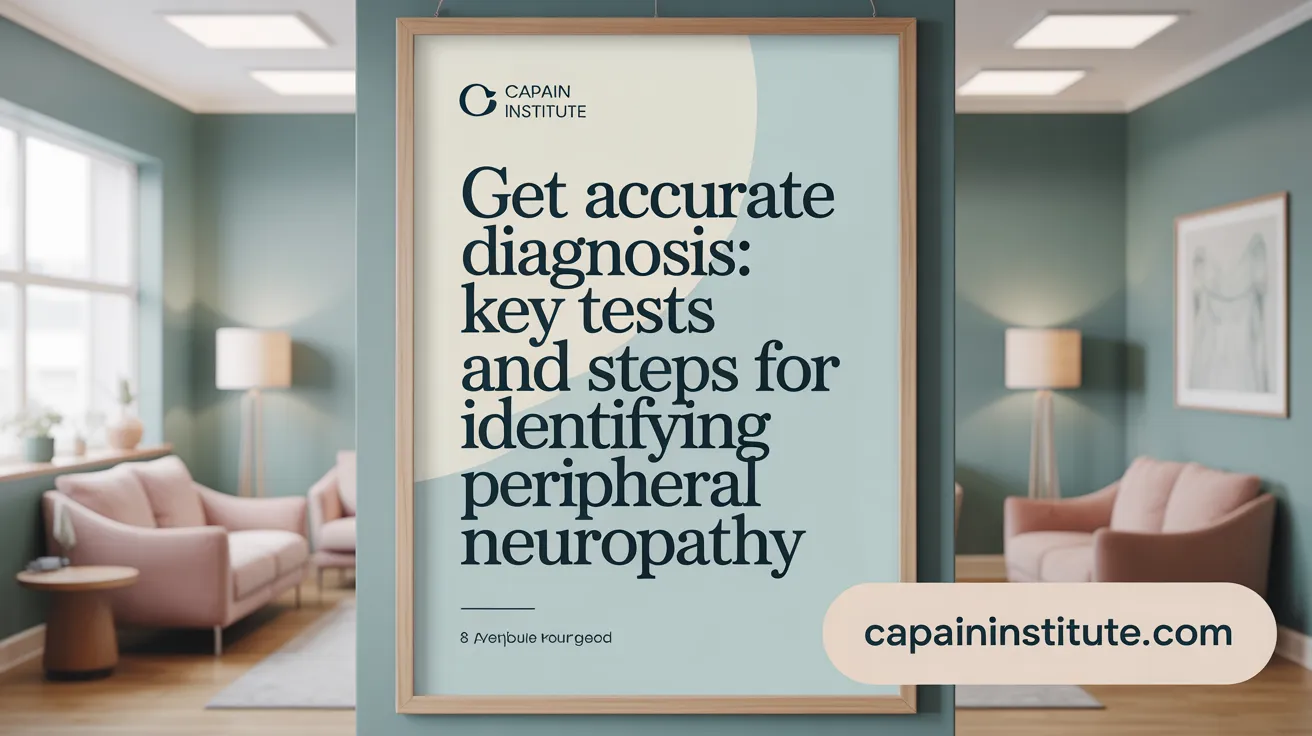Understanding Peripheral Neuropathy: What Patients Need to Know
What Is Peripheral Neuropathy?
Peripheral neuropathy is a condition that affects the nerves outside of the brain and spinal cord, known as the peripheral nervous system. These nerves are crucial for controlling automatic body functions, muscle movements, and sensations such as touch and pain. When damaged, they can cause a variety of symptoms that impact daily life.
Who Is Affected?
Peripheral neuropathy can affect anyone but is more common among older adults, particularly those over 45 years of age. Certain health conditions, most notably type 2 diabetes, greatly increase the risk because high blood sugar levels can damage peripheral nerves over time. Other factors include alcohol use disorder, vitamin deficiencies, autoimmune diseases, infections, and hereditary conditions.
Types of Nerves Involved and Symptoms
Peripheral neuropathy may involve three types of nerves:
- Sensory Nerves: Control sensation, causing symptoms like tingling, numbness, or burning pain.
- Motor Nerves: Control muscle movement, leading to weakness or coordination difficulties when affected.
- Autonomic Nerves: Regulate automatic functions such as blood pressure and digestion, and their involvement can cause symptoms like dizziness or digestive issues.
Symptoms vary depending on which nerves are affected and may range from mild discomfort to severe pain or loss of function. Recognizing these symptoms early is important for diagnosis and treatment.
Common Causes and Risk Factors of Peripheral Neuropathy

What are the common causes of peripheral neuropathy?
Peripheral Neuropathy Overview arises from damage to nerves outside the brain and spinal cord, disrupting sensation, movement, and automatic body functions. The most frequent cause is unmanaged type 2 diabetes, which harms nerves through prolonged high blood sugar levels. This condition is widespread and increases risk as people age.
Most frequent causes like diabetes and alcohol use disorder
Diabetes and Peripheral Neuropathy is the leading cause of peripheral neuropathy globally. Another major factor is Alcohol-related Peripheral Neuropathy, which damages the nerves both directly and by causing deficiencies in essential nutrients required for nerve health.
Vitamin deficiencies and autoimmune diseases
Deficiencies in vitamins such as Vitamin Deficiencies Affecting Nerves like B1 (thiamine), B6, B9 (folic acid), B12, and vitamin E can cause nerve damage and contribute to neuropathy development. Autoimmune Causes of Neuropathy, including Guillain-Barré syndrome and chronic inflammatory demyelinating polyneuropathy (CIDP), also affect peripheral nerves by attacking them mistakenly.
Other causes including medications, infections, trauma, and genetics
Certain medications, particularly Medications for Peripheral Nerve Damage such as chemotherapy drugs, are known to cause nerve damage. Infections like HIV, Lyme disease, shingles, and leprosy may lead to neuropathy by damaging nerves (Infections Causing Neuropathy). Physical trauma or injuries damaging nerves through direct impact or stretching can cause localized neuropathy (Trauma-induced Nerve Injury. Additionally, genetic conditions such as Genetic Causes of Neuropathy like Charcot-Marie-Tooth disease result in inherited nerve disorders, and exposure to toxins or vascular problems also contribute.
Understanding these causes aids in Treatment Options for Neuropathy to manage or possibly reverse peripheral neuropathy, especially with early intervention.
Diagnosing Peripheral Neuropathy: Steps and Tests

Symptom Assessment and Medical History
Diagnosing peripheral neuropathy begins with a detailed review of the patient's symptoms of peripheral neuropathy. This step helps identify any underlying conditions such as diabetes and nerve damage, vitamin deficiencies affecting nerves, or exposure to toxins that may contribute to nerve damage. Patients are encouraged to report all symptoms, including numbness, tingling, pain, and muscle weakness.
Neurological and Physical Exams
Following the history, a neurological and physical examination is performed to evaluate reflexes, muscle strength, sensation, and coordination. These exams help determine the extent and pattern of nerve involvement, differentiating between motor, sensory, and autonomic nerve dysfunction. For more on diagnostic methods, see Diagnostic methods for peripheral neuropathy.
Diagnostic Tests
To confirm the diagnosis and uncover the root cause, physicians use several diagnostic tests:
- Blood Tests: Assess vitamin levels, blood sugar control, autoimmune markers, and infections.
- Electromyography (EMG): Measures electrical activity in muscles to evaluate nerve function and detect nerve damage.
- Nerve Biopsy: Involves taking a small sample of nerve tissue for microscopic examination, useful in certain complex cases.
- Imaging (MRI or CT): Helps visualize nerve roots and surrounding structures to identify compressions or tumors.
- Genetic Testing: Recommended when hereditary neuropathies like Charcot-Marie-Tooth disease are suspected.
Through this comprehensive evaluation process, healthcare providers establish an accurate diagnosis, essential for guiding effective treatment options for neuropathy tailored to individual patient needs. For more comprehensive information on diagnosis and treatment, visit Peripheral neuropathy diagnosis.
Comprehensive Treatment Options for Peripheral Neuropathy

What treatment options are available for peripheral neuropathy?
Peripheral neuropathy treatment is tailored to the underlying cause and the severity of symptoms. Medication is often the first line of therapy, targeting nerve pain and improving quality of life. Common pharmacological treatments include anticonvulsants such as gabapentin and pregabalin, which help to calm nerve activity. Antidepressants like amitriptyline and duloxetine are effective in modulating pain signals in the nervous system. Topical treatments, including lidocaine patches and capsaicin cream, provide localized relief with minimal systemic side effects.
How do physical and occupational therapy help?
Physical therapy plays a critical role in managing peripheral neuropathy by improving strength, flexibility, and coordination. Tailored exercise programs promote circulation and reduce symptom severity. Occupational therapy focuses on adapting daily activities and developing coping strategies to maintain independence and safety, especially in cases where motor or sensory nerves are affected.
What surgical and interventional pain management therapies are available?
For patients with persistent or severe neuropathic pain, interventional pain management techniques procedures offer additional relief. Nerve blocks and spinal cord stimulation are commonly used to interrupt pain signaling pathways. Surgeries to decompress or repair nerves may be indicated in cases of traumatic nerve injury or nerve entrapment. Minimally invasive techniques such as radiofrequency ablation and epidural injections are also employed to target specific pain sources.
What is the role of supportive devices and foot care?
Supportive devices such as braces, orthotic inserts, and mobility aids help stabilize affected limbs and prevent falls. Specialized foot care is especially important for patients with diabetic neuropathy or those experiencing foot numbness and ulcers. Routine inspection, protective footwear, and maintaining good hygiene reduce infection risks and complications.
Integrating these treatments with lifestyle modifications and medical management enhances overall outcomes for individuals living with peripheral neuropathy.
Lifestyle and Self-Care Strategies to Manage Neuropathy Symptoms

What lifestyle changes can help manage neuropathy?
Managing neuropathy effectively involves several lifestyle adjustments aimed at slowing nerve damage and improving quality of life. A primary step is maintaining healthy blood sugar levels, particularly crucial for individuals with diabetic neuropathy management strategies. Careful monitoring and managing diabetes through medication and diet help prevent further nerve injury (Managing diabetic neuropathy).
A nutritious diet rich in B vitamins (like B1, B6, B9, B12) and antioxidants, including omega-3 fatty acids, supports nerve health and may alleviate symptoms. Including foods high in these nutrients or considering supplementation under physician guidance is beneficial (Balanced diet for nerve health.
Regular low-impact physical activity such as walking, swimming, or cycling enhances circulation, promotes flexibility and strength, and can reduce neuropathic discomfort. Gentle exercises also assist with blood sugar control and overall cardiovascular health (Exercise for neuropathy.
Stress management is another vital component. Techniques like meditation, deep breathing exercises, yoga, and mindfulness help reduce anxiety and may decrease symptom severity by lowering pain perception and improving mental well-being (Stress management techniques, Meditation for neuropathy, Yoga and neuropathy.
Proper foot care is essential, especially for those with neuropathy affecting the feet. Daily inspection for injuries, maintaining good hygiene, wearing well-fitted supportive shoes, and avoiding walking barefoot prevent infections and injuries. Additionally, home safety modifications—removing tripping hazards, installing handrails, and using non-slip mats—reduce fall risk and enhance safety (Foot care for neuropathy, Home safety modifications.
By integrating these strategies, individuals with neuropathy can better manage symptoms, maintain independence, and improve their overall quality of life.
Medications in Neuropathy: Tailoring Pharmacological Care
What medications are commonly prescribed for neuropathic pain?
Neuropathic pain management often begins with specific medication classes tailored to target nerve pain effectively. First-line agents include anticonvulsants such as gabapentin for nerve pain and pregabalin. Gabapentin is particularly effective in treating nerve pain related to diabetes and shingles, though dosing adjustments may be needed for patients with kidney issues. Pregabalin shares similar benefits and is widely used to reduce shooting or burning neuropathic sensations.
Antidepressants like amitriptyline uses and effects and duloxetine for diabetic nerve pain serve another crucial role in neuropathic pain treatment. Amitriptyline acts by blocking pain signals at the brain and spinal cord level, though patients should be aware of common side effects such as dry mouth, constipation, and drowsiness. Duloxetine modulates serotonin and norepinephrine pathways, making it effective against diabetic nerve pain.
Topical medications, including lidocaine patches and capsaicin cream relief, offer localized pain relief with fewer systemic side effects, making them suitable for patients who may not tolerate oral medications well.
Role of combination therapy
Combining different classes of medications, such as anticonvulsants with antidepressants or topical agents, can improve overall pain control and reduce the dosage required for each drug. This approach helps enhance symptom relief while minimizing side effects. When medications alone are insufficient, interventional pain management techniques—such as nerve blocks or spinal cord stimulation—are options to further manage pain.
Side effects and considerations
Patients should be counseled on potential side effects related to nerve pain medications. Dry mouth, dizziness, and sedation are common with certain antidepressants and anticonvulsants. Kidney function must be monitored when using drugs like gabapentin. Importantly, opioids are generally avoided due to the risk of addiction and limited efficacy in neuropathic pain.
Non-opioid approaches and alternatives
Emphasizing non-opioid regimens, current best practices combine medications with physical therapies and mind-body techniques for comprehensive management. Non-pharmacological treatments—such as physical therapy benefits, cognitive behavioral therapy (CBT) for pain, and stress management techniques—complement medication to optimize patient outcomes.
Effective neuropathic pain management requires individualized pharmacological plans supported by thorough evaluation and ongoing adjustment to balance symptom control with quality of life.
Interventional and Advanced Pain Management Techniques
What advanced pain management options are available for neuropathy?
Advanced pain management for neuropathy includes a range of interventional pain management techniques and regenerative therapies designed to relieve pain and promote nerve health when standard treatments are insufficient.
Nerve Blocks, Spinal Cord Stimulation, and Radiofrequency Ablation
These techniques aim to disrupt or modulate pain signals from damaged nerves. Nerve blocks involve injections of anesthetic or anti-inflammatory medication to numb specific nerves. Spinal cord stimulation delivers mild electrical pulses to the spinal cord, reducing the perception of pain. Radiofrequency ablation uses targeted heat to interrupt nerve conduction pathways linked to pain, offering longer-lasting relief. Learn more about nerve blocks and nerve stimulation and spinal cord stimulation therapy.
Ketamine Infusions and Implantable Devices
Ketamine infusions serve as an alternative approach, especially in refractory neuropathic pain cases, by dampening nerve sensitization. Implantable devices include spinal cord stimulators and drug delivery pumps, allowing continuous, adjustable therapy directly at the pain source, often reducing reliance on systemic medications. For additional details on ketamine infusions and implantable pain pumps, see California Pain Medicine Center.
Regenerative Medicine Approaches such as PRP and Stem Cell Therapy
Emerging treatments like platelet-rich plasma (PRP) therapy and stem cell therapy focus on repairing and regenerating nerve tissues. PRP uses growth factors extracted from the patient's blood to promote healing, while stem cell therapy aims to replace or rejuvenate damaged nerve cells. More information about regenerative medicine options is available at Source Healthcare's advanced pain treatments.
Role of Multidisciplinary Pain Clinics in Treatment
These clinics offer a coordinated approach combining interventional pain management techniques with physical therapy, psychological support, and lifestyle counseling. The collaborative model ensures that all facets of neuropathic pain are addressed, tailoring treatment plans to patient-specific needs for optimal outcomes. Explore UCLA Comprehensive Pain Centers and interdisciplinary pain management programs for integrated care models.
The Importance of Early Diagnosis and Ongoing Monitoring

Why is early diagnosis crucial in managing neuropathy?
Early diagnosis plays a vital role in managing peripheral neuropathy effectively. Identifying the condition promptly allows healthcare providers to implement timely interventions that can reverse or limit nerve damage. This can significantly improve patient outcomes, preventing permanent disabilities and enhancing quality of life.
Impact of timely diagnosis on treatment success
A swift diagnosis facilitates the development of personalized treatment plans targeting the root cause of neuropathy, such as controlling diabetes or addressing vitamin deficiencies. Early therapy may slow or halt disease progression and reduce symptoms like pain, numbness, and muscle weakness.
Regular follow-up exams and symptom tracking
Ongoing monitoring is essential to assess treatment effectiveness and detect changes in nerve function. Patients are encouraged to maintain symptom diaries and attend scheduled medical appointments for neurological exams and diagnostic testing. This continuous evaluation guides therapeutic adjustments to maximize benefits.
Adjusting treatment plans based on disease progression
Neuropathy progression varies; some forms improve with treatment while others may worsen. Clinicians adapt management strategies accordingly, which may involve modifying medications, introducing physical therapy, or exploring interventional pain management techniques to maintain function and comfort.
Patient education and preparation for medical visits
Educating patients about their condition empowers them to recognize symptom changes and follow treatment recommendations. Preparing for medical visits with detailed symptom records, medication lists, and questions enhances communication and ensures comprehensive care. Early engagement with healthcare providers at reputable centers, such as those specializing in neuropathy treatment in Los Angeles, supports proactive management.
Living Well with Neuropathy: Coping and Support Strategies
How can patients cope effectively with the challenges of neuropathy?
Living with neuropathy can deeply affect emotional and psychological well-being, often leading to anxiety, depression, and stress due to chronic pain and functional limitations. Effective coping starts with recognizing these emotional impacts and seeking appropriate mental health support to manage them.
Support networks are critical in providing emotional resilience. Patients benefit from connecting with family, friends, and peer support groups, which offer understanding, shared experiences, and reassurance. Community resources can also provide educational workshops and support forums, as discussed in Living with Neuropathy.
Stress reduction plays a vital role in managing neuropathy symptoms. Techniques such as mindfulness meditation, deep breathing exercises, yoga, and cognitive behavioral therapy (CBT) for pain have been shown to decrease pain intensity and improve mental health. These practices help patients manage the physical discomfort and the emotional strain of neuropathy, as outlined in Neuropathic Pain Overview and Management.
Patient empowerment through education is essential. Understanding the condition, treatment options, and self-care measures empowers patients to actively participate in their management plan. Educational resources help patients build self-confidence and promote adherence to therapies, dietary adjustments, and lifestyle modifications that support nerve health, as described in Peripheral Neuropathy Overview and Living with Neuropathy.
In summary, a holistic approach combining emotional support, stress management, community engagement, and patient education enhances the quality of life for individuals living with neuropathy.
